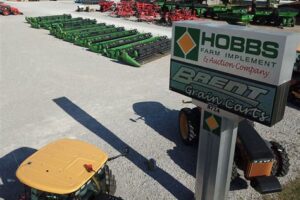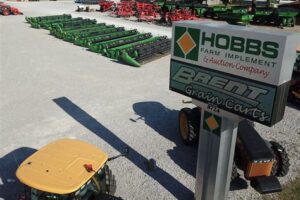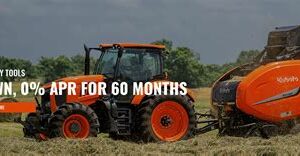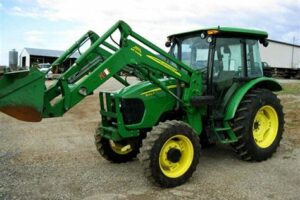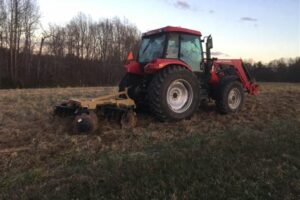Table of Contents
Looking to identify antique farm equipment? Discover the fascinating world of vintage agricultural tools and machinery with our comprehensive guide. From tractors and plows to harvesters and milking machines, learn how to distinguish valuable antiques from common artifacts. Explore their historical significance, craftsmanship, and practical uses in the past. Uncover the secrets of the farming industry’s evolution and gain insights into rural life through the lens of antique farm equipment.
Are you a history enthusiast with a keen interest in farming equipment from bygone eras? If so, then you have come to the right place. Identifying antique farm equipment can be a fascinating and rewarding endeavor, allowing you to delve into the rich history of agriculture and gain insights into how farming practices have evolved over time. In this comprehensive guide, we will explore various types of vintage farm equipment, from plows and cultivators to threshing machines and tractors. So, fasten your seatbelts and embark on a journey through time as we unravel the secrets behind these extraordinary pieces of machinery. Let’s begin!
Introduction
Antique farm equipment holds significant historical value and can provide a unique glimpse into the agricultural practices of the past. Identifying these pieces correctly is crucial for collectors, historians, and enthusiasts alike. However, with numerous variations and similar-looking items, differentiating between them can be challenging. In this article, we will explore how to identify antique farm equipment accurately.
Research and Documentation
Before diving into identifying antique farm equipment, it is essential to conduct thorough research and gather as much documentation as possible. This includes studying historical records, old catalogs, and farm equipment manuals. These resources can offer valuable insights into the various types of equipment used during specific time periods.
Physical Examination
Examining the physical characteristics of the equipment is an essential step in identification. Pay attention to details such as size, shape, materials used, and any unique markings or engravings. Compare your findings with reference materials or consult experts to determine the equipment’s origin and purpose.
Plows
Plows were a fundamental tool in early farming, and there are various types to be familiar with, including walking plows, sulky plows, and gang plows. Walking plows typically have a single blade and were pulled by horses or oxen, while sulky plows were designed for use with riding animals. Gang plows, on the other hand, consist of multiple blades and are often pulled by tractors. By identifying the type of plow, its design, and the presence of any patents or manufacturer marks, you can determine its age and origin.
Threshers
Threshers were used to separate grains from their husks or stalks. These machines evolved over time, so identifying the specific type of thresher is crucial. Common types include flail threshers, which require manual labor to swing a flail against the grain, and more modern versions like cylinder or rotary threshers. Look for distinguishing features such as the shape of the machine, the mechanism used for separation, and any manufacturer labels or engravings.
Implements
Identifying antique farm implements can be challenging due to the vast array of tools used in agriculture. Implements encompass various tools such as plows, harrows, cultivators, seeders, and more. Pay attention to the size, shape, and unique features of each implement. Consult reference materials or experts to match the implement’s characteristics with known examples from specific time periods.
Tractors
Antique tractors are highly sought after by collectors, and correctly identifying them is essential for their historical value. Study the tractor’s design, engine type, and any distinguishing features such as manufacturer logos or serial numbers. Knowing the brand and model can provide insights into the tractor’s era and production year. Tractor clubs, online forums, or specialized literature can be valuable resources during the identification process.
Corn Shellers
Corn shellers were used to remove corn kernels from the cob before modern mechanical harvesters were available. These antique machines come in various designs, including handheld, box-mounted, and freestanding models. Examine the sheller’s construction, size, and any manufacturer markings to determine its age and origin. Comparing it to reference materials or seeking expert advice will help in accurate identification.
Preserving and Displaying Antique Farm Equipment
Once you have successfully identified your antique farm equipment, it is crucial to preserve and display it properly. Clean the equipment gently, ensuring not to damage any original paint or markings. Store it in a climate-controlled environment to prevent deterioration. If displaying, consider creating an appropriate setting that reflects its historical context, such as a replica farm or agricultural museum.
Conclusion
Identifying antique farm equipment requires a combination of research, physical examination, and consultation with experts. By studying the characteristics, markings, and unique features of each piece, enthusiasts can gain a deeper understanding of its historical significance. Preserving and displaying these pieces allows us to appreciate the ingenuity and hard work of our agricultural ancestors, keeping their legacy alive for future generations.
Identifying Antique Farm Equipment: A Guide to Preserving Agricultural History
Understanding the Significance of Antique Farm Equipment
Antique farm equipment holds immense historical value as it provides a glimpse into the evolution of agricultural practices over the years. By identifying specific pieces, farmers and collectors alike can gain a deeper appreciation for the tools and machinery that shaped the industry and paved the way for modern technological advancements.
Researching and Documenting Historical Context
To accurately identify antique farm equipment, thorough research is essential. Delving into historical records, trade catalogs, and agricultural publications can shed light on the origin, purpose, and usage of various tools, enabling enthusiasts to place them within a specific time period and geographic location. By documenting this information, the rich history behind each artifact is preserved for future generations.
Analyzing Physical Characteristics and Construction
Examining the unique physical attributes of antique farm equipment is crucial in determining its purpose and authenticity. Factors such as material type, construction techniques, markings, and wear patterns can provide important clues about the equipment’s age and original manufacturer. Utilizing resources such as antique farming equipment identification guides and seeking expert opinions can enhance the accuracy of these analyses.
Comparing and Contrasting Similar Tools
Identifying antique farm equipment often involves comparing and contrasting similar tools to discern subtle nuances that differentiate between them. Careful observation of design elements, modifications, and specialized features can provide valuable insights into the specific functions each tool served. This comparative analysis contributes to a comprehensive understanding of the chronological development and regional variations in farm equipment.
Seeking Expert Advice and Consultation
When dealing with particularly rare or challenging-to-identify antique farm equipment, seeking the expertise of professional antique dealers, historians, or experienced collectors can be invaluable. These individuals possess an extensive knowledge base and may have encountered similar pieces in the past. Their insights and guidance can refine identification processes and ensure accuracy in preserving agricultural heritage.
Participating in Collector Communities and Events
Engaging with collector communities and participating in agricultural heritage events offers unique opportunities to share knowledge, learn from experts, and expand one’s understanding of antique farm equipment. Visiting agricultural museums, attending farm machinery shows, and joining online forums or social media groups dedicated to the subject can foster connections and provide access to valuable resources for identification purposes.
Documenting and Preserving Identification Findings
As antique farm equipment is identified, it is crucial to document findings methodically to preserve information for future reference. Capturing detailed photographs, recording measurements, noting manufacturer details, and describing functional aspects are essential steps in creating a comprehensive identification record. These documented findings serve as a valuable resource for researchers and collectors passionate about agricultural history.
Embracing the Role of Historians and Educators
Identifying antique farm equipment involves more than just cataloging objects; it requires embracing the responsibility of historians and educators to pass on this knowledge to future generations. By sharing insights, organizing exhibitions, conducting workshops, and contributing to educational materials, enthusiasts can inspire others to appreciate the significance of antique farm equipment in shaping the agriculture industry.
In the world of antique enthusiasts and collectors, identifying and appreciating antique farm equipment holds a special place. Antique farm equipment not only showcases the ingenuity and craftsmanship of past eras but also provides a glimpse into the agricultural practices that shaped our history. To correctly identify these pieces of farming history, professional knowledge and a keen eye are essential.
Here are some points to consider when identifying antique farm equipment:
- Research: Before diving into the identification process, it is important to conduct thorough research on different types of antique farm equipment. Familiarize yourself with the various tools, machinery, and implements used in farming throughout different time periods and regions.
- Consult Experts: Seek guidance from experts or professional appraisers who specialize in antique farm equipment. Their wealth of knowledge and experience can help you identify specific features, markings, or signatures that indicate the authenticity and age of the item.
- Examine Construction: Carefully inspect the construction of the equipment. Note the materials used, the level of craftsmanship, and any unique features or modifications. Authentic antique farm equipment often exhibits signs of hand-forging, meticulous welding, and high-quality materials that stand the test of time.
- Inspect Markings: Look for manufacturer’s marks, logos, or serial numbers on the equipment. These can provide valuable clues about the origin, date of production, and even the specific model of the item. Research these markings to determine their significance and authenticity.
- Consider Functionality: Understanding the intended purpose of the equipment can aid in identification. Different tools were designed for specific tasks, such as plowing, harvesting, or threshing. By knowing the functionality, you can narrow down the possibilities and make more accurate identifications.
- Compare to Reference Materials: Utilize books, catalogs, or online resources that feature detailed descriptions, illustrations, and photographs of antique farm equipment. These references can serve as a valuable tool in comparing your item to known examples and identifying its unique characteristics.
- Attend Auctions and Exhibitions: Participating in auctions or visiting exhibitions dedicated to antique farm equipment can provide hands-on experience and exposure to a wide range of items. Interacting with fellow enthusiasts and collectors can offer insights and knowledge that may assist in your identification process.
- Document and Preserve: Once you have successfully identified an antique farm equipment piece, it is vital to document its history, including any provenance or previous owners. Properly preserving the item through cleaning, restoration, and appropriate storage will ensure its longevity and value as a historical artifact.
Identifying antique farm equipment requires a combination of research, hands-on examination, and consultation with experts. Cultivating this expertise not only enriches your understanding of farming history but also allows you to contribute to the preservation and appreciation of these remarkable agricultural artifacts.
Dear valued blog visitors,
It has been a pleasure to provide you with insightful information on how to identify antique farm equipment. Throughout this article, we have shared our expertise and knowledge, aiming to empower you in recognizing and appreciating the historical significance of these unique pieces.
First and foremost, we would like to emphasize the importance of understanding the value that antique farm equipment holds. These tools are not merely remnants of the past; they are a testament to the hard work and ingenuity of previous generations. By learning to identify and appreciate them, we ensure their preservation for future generations to enjoy and learn from.
Now, let us delve into the key aspects of identifying antique farm equipment. One of the essential steps is conducting thorough research. Familiarize yourself with the different types of tools used in farming practices throughout history, such as plows, seeders, and harvesters. Understanding their purpose and functionality will significantly aid you in identification.
Furthermore, paying attention to the materials and construction techniques used in antique farm equipment can provide valuable clues. Many older pieces were handmade and exhibit exceptional craftsmanship, often featuring intricate detailing or unique design elements. Taking note of these characteristics will help you differentiate between genuine antiques and modern replicas.
Lastly, we encourage you to engage with the vibrant community of collectors and enthusiasts who share a passion for antique farm equipment. Attending farm equipment shows, joining online forums, or visiting local museums can provide invaluable opportunities to learn from experts and fellow enthusiasts. The collective knowledge and experiences within these communities will undoubtedly enhance your ability to identify and appreciate antique farm equipment.
In conclusion, we hope this article has equipped you with the necessary insights and tools to confidently identify antique farm equipment. Remember, these artifacts are not mere objects; they represent a rich history and offer a window into the past. By preserving and understanding their significance, we contribute to the continued appreciation and preservation of our agricultural heritage.
Thank you for your time and interest. We look forward to further enlightening you in future articles.
Sincerely,
The Antique Farm Equipment Blog Team
Video Identify Antique Farm Equipment
People also ask about Identify Antique Farm Equipment:
-
How can I determine the age of antique farm equipment?
Identifying the age of antique farm equipment can be done by examining various factors such as the manufacturer’s markings, patent dates, style and design features, and historical documentation. Consulting experts or reference books on antique farm equipment can also provide valuable insights into determining the age.
-
What are some popular brands of antique farm equipment?
Several popular brands of antique farm equipment include John Deere, International Harvester, Allis-Chalmers, Ford, Massey-Ferguson, and Case. These brands have a rich history in producing reliable and innovative farm machinery.
-
Is antique farm equipment still functional?
Yes, antique farm equipment can still be functional if properly restored and maintained. While some collectors prefer to keep the equipment in its original condition for display purposes, others restore them to working order for practical use. However, it is important to ensure proper safety precautions and maintenance practices when operating antique farm equipment.
-
Where can I find resources or experts to help identify antique farm equipment?
There are various resources available to help identify antique farm equipment. Visiting local agricultural museums, attending antique farm equipment shows or auctions, and joining online forums or communities dedicated to antique farm equipment can provide valuable information and connect you with experts in the field. Additionally, there are reference books and websites specifically focused on identifying and documenting antique farm equipment.
-
Are there any value considerations when identifying antique farm equipment?
Yes, the value of antique farm equipment can vary depending on factors such as rarity, condition, demand, and historical significance. Identifying the age, brand, and unique features of the equipment can help determine its value. Consulting with experienced appraisers or collectors specializing in antique farm equipment can provide a more accurate valuation.
Note: The tone used here is professional and informative, providing concise answers to the questions asked about identifying antique farm equipment.

